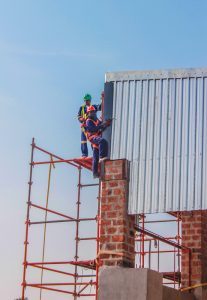Ladder Safety On Construction Site In New York City Faqs

While multiple factors play a role in construction site ladder accidents, two of the most common ones involve poor placement of the ladder and workers reaching away for tools and materials. However, many workers suffer serious or fatal injuries because their employers provide them with the wrong types of ladders for the tasks being assigned.

The following information notes critical ways that employers and workers can minimize dangers and injuries by answering questions frequently addressed in both government and industry studies.
Ladder safety On Construction Site FAQs
- Are workplace ladder fall injuries often age-related?
Yes. Older men tend to fall the most off ladders. However, ladder injuries requiring emergency room treatment often involve a wider age span.
- What are the most common injuries suffered due to falling off a ladder?
Bone fractures (usually involving an extremity) — as well as fractures imposed on the tibia, fibula, and the pelvic area. Some workers also suffer a traumatic pneumothorax (or collapsed lung). Various traumatic brain and spinal cord injuries may also be sustained.
- How many days away from work occur after serious ladder fall injuries?

- Which ladder safety rules are most frequently forgotten by workers?
Perhaps the most critical one is that workers must always maintain three points of contact with the ladder. Stated differently, you must keep holding on to a ladder with both hands while balancing on one foot – or standing with both feet on the ladder and holding on with at least one hand.
Balance problems almost immediately occur when this key rule is ignored. Another rule workers sometimes feel they must ignore (when under pressure from a supervisor) is that heavy tools or materials should never be carried up ladders.
- What is the safest type of ground to have beneath a ladder?
It must be dry, level, and free of debris. Workers should never try to balance a ladder on uneven ground.
- Are there any types of injuries now receiving more attention due to ladder fall injuries?

- What types of safety features should employers require on all their ladders?
Workers stand a far better chance of avoiding injuries when their ladders have proper fasteners, stabilizers, extender arms, rubber feet, and hooks. Only ladders that come with detailed safety instructions should be ordered. Workers must receive training that clearly indicates when tasks require the use of fiberglass, wood, or aluminum ladders.
- Can workers use their own judgment when deciding on the right angle for leaning a ladder against the building?
No, that can prove quite dangerous. Ladders must normally lean at approximately a 75% angle from the horizontal position.
- Should substance abuse issues be covered during ladder safety training sessions?
Yes. Supervisors must never allow any workers to climb up ladders who appear to be under the influence of alcohol or any type of drug.
- Are there any other simple rules that workers must keep in mind each day that they use ladders?
Yes. No more than one person should ever climb up or down a ladder at a time. Also, it is always safest to climb up or down a ladder while positioned in the middle of it. Finally, by spending just five full minutes inspecting a ladder before using it on any given day – you can save your life or prevent serious injuries that could result in a lifetime of pain.
- When Does a Ladder Require a Cage?

5 Things Workers Need to Do Before Getting on a Ladder On A Construction Site

Investigations after injuries often reveal the following ladder safety mistakes
- Improper maintenance and storage. Every ladder must be fully inspected and wiped down after each work shift. This increases the chances that loose or missing parts will be found, and the ladder surfaces will be cleaned throughout the day – lowering the fall risks for workers starting later shifts.
- Errors were made in the design or manufacturing of a ladder. Rungs may be improperly spaced apart or there could be damage to other parts like the safety shoes (or “feet”) of the ladder.
- An A-frame ladder was used in a closed position. These types of ladders were built in a specific way to help workers maintain their balance. When an A-frame ladder is left closed, the ladder’s unique design features can compromise safety.
- A ladder was placed too close to overhead electrical lines.
Get Legal Help For Construction Site Accident
If you have suffered severe injuries after a construction site ladder accident — caused by someone else’s negligence — you need to contact our New York City ladder accident law firm. We will carefully investigate all the facts of your case, review all your medical records, and then fight hard to win the maximum compensation available. We want every client to fully recover for all lost wages, pain and suffering, medical expenses, and other losses.



